§1. INTRODUCTION
Like other contacts between Cultures, the 17th century exchange between China and the West can be studied from different perspectives A first focus is the question of presentation: "What did the missionaries do to introduce and proclaim Christianity in China?" But there is also the question of reception: "How did the Chinese react to the missionaries? How did they accept Christianity or the Western sciences?" One can distinguish between the positive reception or acceptance, and the negative reception or rejection.
This paper would like to illustrate these different perspectives by selecting one theme: the idea of Heaven and Hell as proclaimed by the Jesuits. How was it accepted or rejected by Chinese scholars and others at the end of the Ming Dynasty? It is hoped that such an approach can also contribute to a better understanding of the interaction that takes place when two different Cultures meet on an intellectual or popular level.
§2. WESTERN PRESENTATION
I would like to concentrate mainly on the Chinese reaction, but let me first briefly examine what general understanding there was of heaven and hell in European culture in those days and how the missionaries presented this idea.
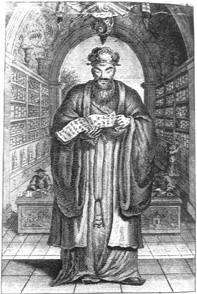 Confucius, Chinese philosopher.
In: DU HALDE, Jean-Baptiste, S. J., A description of the empire of Tartary and Chinese Tartary [...], 2 vols., London, Printed by T. Gardner for Edward Cave, 1738-1741, vol.1, fly page- detail.
Confucius, Chinese philosopher.
In: DU HALDE, Jean-Baptiste, S. J., A description of the empire of Tartary and Chinese Tartary [...], 2 vols., London, Printed by T. Gardner for Edward Cave, 1738-1741, vol.1, fly page- detail.
The understanding of Heaven and Hell which the Jesuits brought to seventeenth-century China corresponded to the European world-view of their time, the basis of which was laid in the thirteenth century with Bonaventure (°1221-†1274) and Thomas Aquinas (°1225-†1274). Heaven was above the Earth. In fact, one distinguished three heavens. The highest Heaven was the caelum empyreum where God, the angels and the saints dwelt. Then came the crystalline Heaven, caelum cristallinum, which was formed by the element Water and which connected the Highest heaven with the third and lower Heaven, caelum stellatum. This Heaven of stars, also called caelum firmamentum, was already considered by the Greeks and later scholars as the all-surrounding sphere. Under these three Heavens, there were the seven spheres of the Planets (under which the Sun and the Moon were reckoned). Hell was at the Earth's core. There the devils and the damned were tortured physically (by fire) and mentally (by absence of harmony and by the community of the damned) Above Hell was Purgatory, where sinners expiated their sins. There was, moreover, the limbus puerorum, a limbo also situated above Hell, for non-baptized children below seven years of age, and the limbus patrum, a limbo for the "Fathers" who lived before Christ and who were liberated during his "descent into Hell". After death the just would go to heaven and the wicked to Hell
These ideas were faithfully presented in the Chinese writings of the Jesuits. One can, however, distinguish between different types of writings The writings which proved to be most influential were general introductions to Christianity, often written as a dialogue between a Westerner and a Chinese, such as Matteo Ricci's(°1552-†1610) Tianzhu shiyi (1603)or Jiren shipian (1608), or Giulio Aleni's Sanshan lunxueji. 1 These works include a general description of heaven and hell. Their existence is proved by means of scholastic rational argumentation, proofs taken from the Chinese classics, quotations from the Bible or theologians and miracle stories. More detailed descriptions of the human condition in heaven or in the four different "hells" can be found in catechetical works, such as A. Vagnone's (°1568-†1640) well-known catechism Tianzhu jiaoyao jielüe (1615), or doctrinal writings, such as his Simolun (Treatise on the Four Last Things) (1624), 2 destined for those who were already more advanced in the knowledge of Christian doctrine. Since at that time science and theology were not disconnected, it was normal that Christian doctrine on Heaven also appeared in astronomical writings such as E. Dias' (°1574-†1659) Tianwenlüe. Finally, one can find pictorial representations of their theories. For instance, Giulio Aleni's (°1582-†1649) illustrated Life of Christ Tianzhu jiangsheng chuxiang jingijie contains a representation of Christ's descent into Hell, in which the four different levels of Hell are clearly distinguished. This picture is a Chinese adaptation of an illustration in Hieronymus Nadal's (°1507-†1580) Evangelicae Historicae Imagines. 3
§3. CHINESE REACTION
Here also, let me start with a brief presentation of the general understanding of heaven and Hell in 17th century Chinese Culture.
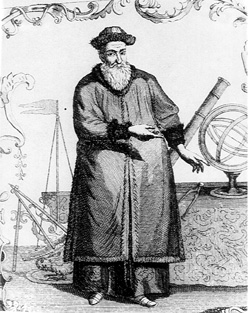 Le Pere Ferdinand Verbiest, Belgian Jesuit.
In: DU HALDE, Jean-Baptiste, S. J., Description Geographique, Historique, Chronologique, Politique, Et Physique, De L' Empire de la Chine et de la Tartarie Chinoise, [...], 4 vols., Haye,Chez Henri Scheurleer, 1736, vol. 3, p. 87 - detail.
Le Pere Ferdinand Verbiest, Belgian Jesuit.
In: DU HALDE, Jean-Baptiste, S. J., Description Geographique, Historique, Chronologique, Politique, Et Physique, De L' Empire de la Chine et de la Tartarie Chinoise, [...], 4 vols., Haye,Chez Henri Scheurleer, 1736, vol. 3, p. 87 - detail.
In China, there were mixed opinions about Heaven and Hell. The existence of a Heaven and a Hell after death was not at all Confucian. Confucians had but a vague notion of life after death Following Confucius they were interested in life here on Earth. They aimed especially at reaching an ideal state of harmony and well-being in life. They had some idea of Tian (Heaven) understood as a cosmic power which rewarded good and punished evil Reward and punishment followed a law of action and reaction. A good deed produced a proportionate good reaction, an evil one a bad reaction But all this happened in this World: reward came by way of success in examinations or numerous offspring. Rewards and punishments could also pass to posterity.
Heaven and Hell as places of happiness or distress in the afterlife, however, are found in Chinese Buddhism, but these clearly differ from those of Christianity In the unending cycle of birth and death there are liudao (six paths) of reincarnation to a new life. The karman which one has at the moment of death, automatically elicits a reaction or requital or reward and determines the manner of one's reincarnation: as a deva (Divine being), nara (human being), asura (demon), tiryagyoni (animal), preta (hungry ghost) or naraka (inhabitant of Hell). Basic here is the belief that these modes of existence are transitory and remain subject to the law of karman: to be in Hell or in Heaven therefore is not to be there forever. There are many Heavens and Hells in Buddhist tradition: One usually counts twenty-seven Tian (Heavens), or Tiantang, where the deva lead a happy life and ten Hells where the damned are tortured in different ways. The Heaven or Hell where one finds oneself depends on the accumulated karman. There is a very lively interest in Hell in popular Buddhism and the theme also appears in other forms of popular religious expressions.
3.1. ACCEPTANCE
I will first give three examples of positive reception and acceptance of the Christian idea of Heaven and Hell. It will soon appear that the way of acceptance varied according to the sociological background, the sub-Culture and the personal interest of the receiver.
3.1.1. Moral Interpretation
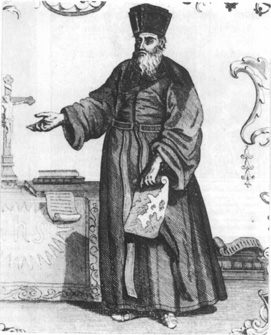 Le Pete Matthieu Ricci, Italian Jesuit.
In: DU HALDE, Jean-Baptiste, S. J., Description Geographique, Historique, Chronologique, Politique, Et Physique, De L'Empire de la Chine et de la Tartarie Chinoise, [...], 4 vols., Haye, Chez Henri Scheurleer, 1736, vol. 3, p. 87 detail.
Le Pete Matthieu Ricci, Italian Jesuit.
In: DU HALDE, Jean-Baptiste, S. J., Description Geographique, Historique, Chronologique, Politique, Et Physique, De L'Empire de la Chine et de la Tartarie Chinoise, [...], 4 vols., Haye, Chez Henri Scheurleer, 1736, vol. 3, p. 87 detail.
The first example concerns two men of letters: Paul Xu Guangqi (°1562-†1633) and Leo Li Zhizao (°1565-†1630) Having succeeded in their examinations they both became officials. In their work they became very interested in shixue ("concrete studies") such as geography, cartography, astronomy and mathematics. Their interest brought them into contact with Ricci, from whom they gained greater knowledge of Western science. They did not limit themselves to Western science, however, for they accepted Western religion as well and were baptized.
When they learned the Christian teaching on Heaven and Hell, they were at first startled. The Chinese writings of the Jesuits underscore strongly the fact that this World is a vale of tears and that the only true litre is in the hereafter. This was contrary to Confucian teachings and we should not be astonished that Xu Guangqi and Li Zhizao associated the Christian understanding of life after death with Buddhism. 4 Ricci explained to them that this Buddhist vision of Heaven and Hell was originally Western; it was taken over by the Buddhists who combined it with the reincarnation theory of Pythagoras. 5 He pointed to the advantages of reminding oneself often of death: one then tried to do good and to avoid evil, coming to disdain possessions, merits, honours and riches, and to conquer one's pride. The reminder of death both simulates and cautions. This explanation was decisive for Xu Guangqi and Li Zhizao; they then accepted the Christian idea of Heaven and Hell in the same way that some Confucians accepted the Buddhist view, that is, because it helped ordinary people to do good and avoid evil.
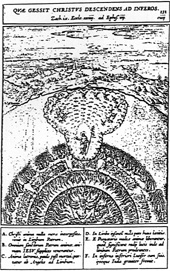 Christ descending to Hell, its Four Levels being distinctively depicted in the illustration.
In: NADAL, Hieronymus, Evangelicœ historicœ imagines [...]auctore Hieronymo Natali[...], Antuerpiœ, Societatis Iesu, 1593, ill. 131.
Christ descending to Hell, its Four Levels being distinctively depicted in the illustration.
In: NADAL, Hieronymus, Evangelicœ historicœ imagines [...]auctore Hieronymo Natali[...], Antuerpiœ, Societatis Iesu, 1593, ill. 131.
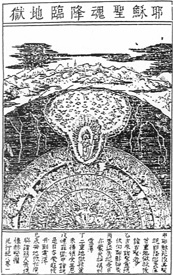 Christ descending to Hell, a Chinese adaptation of Hieronymus Nadal's illustration.
In: BNP: Courant 6750-ALENI, Giulio, S. J., Tianzhu jiangsheng chuxiang jingjie, [ca1635].
Christ descending to Hell, a Chinese adaptation of Hieronymus Nadal's illustration.
In: BNP: Courant 6750-ALENI, Giulio, S. J., Tianzhu jiangsheng chuxiang jingjie, [ca1635].
Xu Guangqi clearly explained this conviction in his Bianxue zhangshu memorandum, addressed to the Imperial Court, in defense of Christianity, during the persecutions of 1616. 6He argued that, in his view, in spite of its teachings about the hereafter Buddhism had not succeeded in bringing about a moral society in China. Christianity however exhorted people to do good, to merit Heaven, to love parents, to be loyal towards superiors and to avoid evil. With its teaching on Heaven and Hell, Christianity could "complement Confucianism and transform buru yifo (Buddhism)". Li Zhizao also considered the idea that Christianity inspired people to do good and overcome evil to be of great importance. Among Christian values he singled out those that were also taught in Confucianism, such as justice, neighbourliness, respect for parents and worshipping Heaven. The thought of Heaven and Hell, however "un-Confucian", was nevertheless acceptable, because, as he wrote, "it warns the stupid and frightens the lazy."7
These two Confucian savants were only moderately interested in Ricci's more doctrinal controversies. What mattered for them in the first place was the question of how best to live a virtuous life and how to build up a moral society. It was in this sense that they accepted the idea of Heaven and Hell and adapted it to make it acceptable in Confucian tradition. Rather than an eschatological meaning, the idea was given a more ethical meaning in terms of pursuit of virtue.
3.1.2. Return to the "Original" Meaning
A second example is that of Michael Yang Tingyun (°1562-†1627). Yang Tingyun had the same social background as Paul Xu Guangqi and Leo Li Zhizao. He was an official but clearly had another field of interest. Science fascinated him less than philosophy and religion. He was a fervent Buddhist and a follower of an important Buddhist movement, in Hangzhou, his native town. He came to know the Jesuits and was so impressed by their teaching that he asked for baptism and received the Christian name Michael.
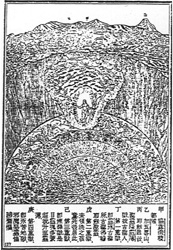 Christ descending to Hell, a nineteenth century adaptation from the Tianzhu jiangsheng chuxiang jingjie,
In: ALLENI, Giulio, S. J., Tianzhu jiangsheng yanxing jilue, in: "Daoyuan jingcui", Shanghai, 1887.
Christ descending to Hell, a nineteenth century adaptation from the Tianzhu jiangsheng chuxiang jingjie,
In: ALLENI, Giulio, S. J., Tianzhu jiangsheng yanxing jilue, in: "Daoyuan jingcui", Shanghai, 1887.
What did he think of Heaven and Hell? Broadly he accepted the Western view, probably because he knew Heaven and Hell from Buddhism. He understood it, however, as a theory of "three Worlds": the highest was the World of Pure Bliss, the lowest was that of Pure Suffering, while in the World in between, where we now live, Bliss and Suffering were mixed. Man himself was responsible for his upward or downward movement. The main point of interest for us is that he described the three spheres using transliterations. In "transliteration" you do not Translate a word from another language, but reproduce it in your own language with its sounds and syllables as a basis. Thus, Michael speaks of ba-la-yi-suo for paraiso [in Portuguese: paraiso] or Paradise, of yin-fu-er-nuo for inferno [in Portuguese: inferno] or Hell and of meng-duo for mundo [in Portuguese: mundo] or the World-in-between. 8 This is very unexpected. In line with their adaptation method, the Jesuits had translated these notions into Chinese using the Buddhist words Tiantang and Diyu [in Portuguese: Deus] or God. But, as mentioned earlier, they also taught that the Buddhists had stolen the ideals of Heaven and Hell from the West and had joined them to the reincarnation theory of Pythagoras. This, they said, was how these ideas had come to China. Basing himself on this original idea for Cultural transposition, Michael Yang Tingyun posited that in course of transposing these notions first into Sanskrit and then into Chinese, their original meaning had been lost. 9 By means of these transliterations he thus aimed to emphasise the so-called original and undistorted meaning of the Christian Heaven and Hell.
Here, then, we have to do with a way of substitution where elements of one religion are replaced by elements of another. This is very clear in this case. The Buddhist idea of Heaven and Hell is rejected only because it is thought to be a twisted version of the Christian idea. Yang Tingyun thought that the Christian idea of Heaven and Hell as a value for the hereafter was a good substitute for the Buddhist idea and a useful contribution to Confucianism, a treasure to be adopted. Confucianism was in no way rejected. Michael was of the opinion that Christianity and Confucianism could only benefit from mutual collaboration.
3.1.3. Visiting the Underworld
For the third example we must pass to another level. The two first examples concerned people from the literate elite. The Jesuits, however, also had many contacts with sections of society which had little or no education. When among intellectuals they proclaimed the Gospel in a rational and scholastic manner, but they entered the world of miracle stories and exorcisms to convert the popular sub-Culture. This gave rise in China to Christian miracle stories, which had much to do with Heaven and Hell.
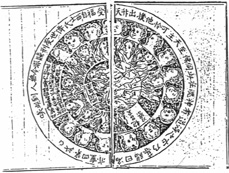 Level Four.
It represents the Nightfall in Hell. Here the Innocents wait for the Divine Mercy to give them the right to enter Paradise.
In: MAYOR T., Simbolo de la Fe, en lengua y letra Cina, 1607, [n. n]-detail.
Level Four.
It represents the Nightfall in Hell. Here the Innocents wait for the Divine Mercy to give them the right to enter Paradise.
In: MAYOR T., Simbolo de la Fe, en lengua y letra Cina, 1607, [n. n]-detail.
Journeys to the Underworld (also called the "apparent death theme") form a literary genre widely diffused in Western Christian Culture. 10 The pattern of these narratives is fairly regular. Somebody very sick or about to die has a vision. An angel comes to fetch him to bring him to the place of Judgement. There he sees God seated on a high throne judging the dead: most are sent to Hell, few allowed to enter Heaven. His turn comes with questions and answers about the sins he committed. The Judgement follows. Then he may recover consciousness for a short time to narrate his experiences, before he finally dies. Or he may he given the grace, through a Saint's or Mary's intercession, to return to life. The purpose of these narratives is to exhort people to practise virtue. But in most cases the subject has this extraordinary chance to do good, so that he does not have to go to Hell later on. After the Judgement there is often a visit to Hell, the horrors of which are then extensively described for the spiritual benefit of the living. The subject sees people he has known before. They pass on messages for their relatives exhorting them to lead a good life, so that they too may not end up in Hell.
Accounts of visits to the Underworld can also be found in Chinese tradition. It was one of the traditional themes of strange tales, the Zhigai and it can be found in the Lieyi zhuan, the earliest collection of strange tales. Visits to Hell were also one of the most common motifs of the Chinese Buddhist miracle tales which became popular in the Tang Dynasty. Well-known are the visits to Hell by the Taizong Emperor and the journey of Mulian in search of his mother. From the late Ming period, there is, among others, a tale found at the end of the Sanbao Taijian xia xiyang ji a fictitious account of an expedition of Zheng He. 11
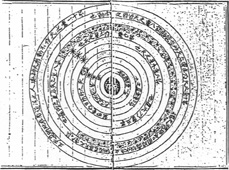 Level Nine
It represents the Ninth Heaven, This Level controls the lower Levels. God and all the Saints live in Level Twelve.
In: MAYOR T., Simbolo de la Fe, en lengua y letra China, 1607, [n. n.]-detail.
Level Nine
It represents the Ninth Heaven, This Level controls the lower Levels. God and all the Saints live in Level Twelve.
In: MAYOR T., Simbolo de la Fe, en lengua y letra China, 1607, [n. n.]-detail.
3.1.4. Epilogue
Interesting for our research is that there are also three similar stories from the early period of Christianity, in China. 12 The first and most influential account concerns the death of Zhang Shi, the third son of Zhang, a very active convert. The second very similar story tells of an experience of Matthew Chen, who belonged to the very active Christian community of Fujian. The third account of a visit to the Underworld is a much longer text and is also related to the same community. All tell about young converts who visited the Underworld and reported about what happened there. When we compare the Chinese Buddhist and the Chinese Christian miracle tales, the similarities are striking. The Chinese Underworld is to a great extent a reflection of the World of the living. This is especially the case with the Court of Justice, which clearly reflects Chinese officialdom. The ruler and Judge of the Underworld is Yama. In Christian stories it is God. Yama has an panguan (assistant). In Christian stories this assistant is the Archangel Michael. The register of their good and evil deeds which the dead carry with them clearly reflects the official system. Also the Christian description of various compartments in Hell compares well with the numerous Hells of popular Buddhism.
Thus in general character the stories are very similar. The story-tellers as well as their audience, appear to consider their miracle stories as narrating real events. This appears from the precise reference to persons, places, dates and hours. Besides, they all have a didactic purpose. The unusual anecdote did not satisfy the authors. Their aim was to show the efficacy of Faith and the Truth of doctrine. There are, no doubt, in those stories certain specifically Christian elements, such as protector saints or the merciful intercession of Mary but what interests us especially here are the similarities. On the one hand, the Jesuits understood these stories to be typically Christian; they were familiar in the West and proved to be a good means of spreading Christianity. On the other hand, the Chinese understood these stories in line with their own tradition. They found things in them which were also found in their tradition, albeit with some Christian corrections. This is what made it possible for these stories to spring up and be accepted. Here again, then, we find a very different way of absorbing Christianity.
3.2. REJECTION
After these three examples of accepting Christianity, let us pause for a moment to consider the negative reaction to it. We should not forget that Christianity elicited a lot of opposition, often stronger than its support. Let us then have a closer look at the views of opponents concerning the teachings on Heaven and Hell.
3.2.1. Confucian Opposition
The Confucian opponents hold that the Christian idea of Heaven and Hell is the same as that of the Buddhists. This is not strange, for as we have seen, the first reaction of several converts such as Paul Xu Guangqi and Leo Li Zhizao was similar. Moreover, the opponents hold that it was wrong to contend that the Buddhists stole the idea of heaven and Hell from the West because, according to them, it was precisely the Jesuits who had stolen the idea from the Buddhists. This is equally clear from the fact that the missionaries, whilst strongly criticizing the Buddhists, had not yet been able to give a proof of their own for the existence of Heaven and Hell. The Confucian critics thus felt that this whole controversy between Christians and Buddhists about what for them was a false theory, was very foolish. 13 Even more fundamental, these opponents considered the Christian theory of reward in heaven and punishment in Hell an unbecoming or even unjust system. In the first place because people would act from motives of personal gain. A noble Confucian does good regardless of the after-life. To aim at a reward is a disgrace! 14 Many Confucian intellectuals, moreover, found it very strange that the Jesuits could bring new techniques and sciences to China and at the same time preach such vulgar theories. They felt it extremely unfair that Heaven should be reserved only for Christians, other good people being excluded from it. The system would be acceptable if it stimulated the common man to do good. But, said the opponents, this was not the case. The proof lay with the Jesuits themselves: they were unmarried and had left their country. This, the critics considered, displayed a lack of filial piety towards parents and loyalty towards the ruler, two fundamental Chinese values. 15
The Confucians criticized the Jesuits especially because they attached so little value to earthly existence. 16 They opposed, for example, the limbus puerorum, the place destined for unbaptized children of less than seven years according to the theology of those days. These children would receive a privileged position in comparison with unbaptized adults who are dispatched to a deeper Hell. The critics found this an especially dishonest system because, they argued, it would then be better "to die young and stupid rather than old and wise."17 The controversy about true virtue is also noticeable in the dispute concerning the place of Confucius and the mythical Sacred Emperors Yao, Shun and Yu. For the Chinese, these were the examples par excellence of virtue and harmonious government. The Catholic theology of those days placed them in the limbus patrum, the "limbo of the fathers." For they died before Christ, and Christ was the first to open the gate of Heaven. It is easy to imagine the strong reactions of the Chinese when they heard from the Jesuits that these supreme models of virtue and morality were condemned to Hell. 18 These are the main lines of the Confucian critique of the Christian teachings on Heaven and Hell.
3.2.2. Buddhist Criticism
Buddhist criticism was much less strong because their views were so similar to the Christian.But they considered that the Jesuits lacked a deeper knowledge of tian deva (Heaven), even if they venerated the Tianzhu ("Lord of Heaven"). Since they did not know the devas of kamadhatu (realm of desire), rupadhatu (realm of form) and arupyadhatu (realm of formlessness), they did not realize that their deva was only one among thousand. 19They defended themselves, of course, against Christian attacks on the theory of rebirth. Indeed, they discerned in the Christian teaching of Heaven and Hell an actual proof of rebirth: for Jesus came from Heaven, became man, died and descended to Hell, rose from death, became man again and finally ascended to Heaven. These three ways of existing, dwelling in Heaven, on Earth and in the Underworld, correspond to three (deva, nara, naraka) of the six modes of existing in the Buddhist cycle of rebirth. The Buddhists here claimed to find a corroboration of their theory. 20 In this sample of criticisms by the opponents of Christianity concerning the idea of Heaven and Hell, the arguments appear to he purely religious, but in reality the issues went much further. The religious is linked to the Sacred and moral order. Thus the opponents considered that Christianity was a yiduan ("heterodox teaching"). They held that if Christianity spread it would become a serious threat to the stability of the state, Confucian orthodoxy and the moral life of the people. There lay the origin of the repeated persecutions of Christians.
§4. CONCLUSION
In this paper I have outlined succinctly what happened to one Christian idea in the early seventeenth-century China. Similar analyses could be made of other religious elements. More important, however, than the changes which the idea of Heaven and Hell has undergone, are the perspectives from which this missionary period has been studied: presentation, acceptance and rejection, as well as the distinct roles of the missionary and the convert.
The conversion of these intellectuals has often been regarded as a mechanical process. After their baptism, they would have thrown off all "superstition" and adopted Christianity in its "pure form." If this were true, this evolution would have been an exception in the whole history of Christianity. In fact, from the beginning Christian Doctrine has been interpreted in Greek concepts and has been "Hellenised." In Northern European countries, local religious traditions (Germanic and Cellic Cultures) were integrated into the "foreign religion" and their traces can still be found today (eg: Christmas tree, Santa Claus and others).
The mission in China at the end of the Ming Dynasty was more than a simple proclamation and acceptance of Christianity. It was one of the most important encounters between two major Cultures. In this encounter one finds elements which are characteristic of any contact or communication between Cultures.
An important principle or inter-Cultural contact is that in a first phase a Culture accepts only those new elements which in one way or another agree with its own Culture pattern. This is the case with individual contacts: in the first place a person accepts another person's ideas because they are close to his own. A second step is accepting something that does not fit into the existing pattern. Foreign ideas are rarely accepted as they are; they are first cut down to size and interpreted in terms of one's own Culture, and the new interpretation may differ widely from the original one. Yet this normally precedes an eventual acceptance or rejection.
When Christianity and China met, as was explained in our historical example, the process of interpretation could be summed up in the following scheme. Here too we distinguish between the main agents.
The Jesuits missionaries who had received their training in the West, were steeped in Western ideas and theology. To pass these on to the Chinese they followed the progressive method of adaptation. They wanted to preach the Gospel in Chinese, and accordingly they first had to translate. To do this, they first interpreted, from their Western Christian tradition, the Chinese language, tradition and thought. Here they accepted or rejected selectively certain Chinese concepts, ideas or currents. We have seen how they chose the Buddhist terms Tiantang and Diyu to translate Heaven and Hell. Finally, then, they presented Christian thought in an interpreted Chinese terminology.
A similar process of interpretation took place on the Chinese side. The Western Christian thought which they encountered was already translated into Chinese. In their turn they interpreted this out of their own tradition and Culture. They also made a selection, and accepted or rejected some ideas. Eventually, they expressed their reinterpretation of Christianity in their writings. Figures such as Paul Xu Guangqi, Leo Li Zhizao and Michael Yang Tingyun were thoroughly schooled in Confucianism or fully at home in Buddhism. They too selected, accepted or rejected some ideas. The Christianity they accepted in their writings was an interpreted, one can even say an inculturated form.
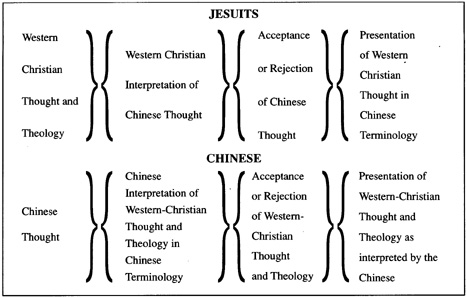
We can observe several degrees of inculturation. Most often, through the process of new interpretation and selection, there occurs a 'value' or 'accent shift'. For believers such as Paul Xu Guangqi and Leo Li Zhizao, the primary meaning was a moral one, not an eschatological one. There is also' substitution' when an idea or religious custom in a local tradition is replaced by one with a similar function from a foreign tradition. This was the case of Michael Yang Tingyun who replaced the Buddhist Heaven and Hell by the Christian ones. But Yang Tingyun's acceptance was accompanied by the phenomenon of 'counter-accommodation'. This is when an adapted form of a religion is rejected for what is erroneously thought to be its most ancient and orthodox form. Yang Tingyun gave preference to the transliterations ba-la-yi-suo, vin-fu-er-nuo, and meng-duo for paradise, hell and world, because he believed these terms to be more ancient and original than the Buddhist terms used by the Jesuits. This phenomenon is quite common: a missionary wants to adapt his religion to an alien culture, hut the convert wants to change his life by renouncing all his past and will oppose anything too closely resembling his earlier religion. Another way of interpretation is absorption. The ideas which are the most easily absorbed, are those which are believed not to be foreign, as were miracle tales of visits to the underworld in the popular culture. These are but a few forms of the phenomena of inculturation resulting from contacts between Cultures. It is important to notice that similar ways of interpretation occurred on the side of those who rejected Christianity, since Confucians and Buddhists also looked at Christianity from their background, be it the sacred Emperors or the reincarnation theories.
This scheme is applied here to what happened in seventeenth century China, but it would also apply to other cases of inter-Cultural contact. Yet this scheme should not be applied too mechanically. It is certainly not a simplification of a complex phenomena, but it rather aims at seeing more clearly the complexity of Cultural interaction. Moreover, not only language but also the Culture, the historical situations and personal encounters have a far from negligible influence upon interpretation. Finally, however reasoned-out it may be, the ultimate personal motivation to accept or reject a new religion is in most cases beyond the reach of investigation. Faith ultimately is and remains a matter of the heart.
What is now the significance of this early period of Christianity in China for the "foundation of dialogue" which this conference proposes to analyse. Was the seveteenth century contact a "dialogue of misapprehension"?21Chinese and Westerners certainly have often evaluated each other from their own dynamic perspectives and this led in several cases to mutual non-understanding. With the distance of time, however, we are able to analyse these perspectives more closely and as such become aware of our own perspectives which influence the dialogue between China and Christianity as much as in the seventeenth century. This is one "foundation of dialogue". On the other hand one can state that a real effort at dialogue took place in the seventeenth century. In this dialogue with such a different partner, both China and Christianity revealed some of their hidden aspects. It is only through the dialogue with the "other" that one can discover the similarities and differences, the universals and particulars, and that one can start to walk in the way of mutual enrichment. Therefore, it is not the initial difference which is important, but to be engaged in a dialogue. This could be called the second "foundation of dialogue".
CHINESE GLOSSARY
arupyadhatu 無色界
asura 阿修羅
"ba-la-yi-suo"罷辣依瑣
Biantian sanshuo 辯天三説
Bianxue zhangshu 辨學章疏
buru yifo 補儒易佛
Can yuangyi shu 參遠夷疏
Daiyi pian 代疑篇
Daiyi xupian 代疑續篇
Daoyuan jingcui 道原精華
diyu 地獄
Huang Zhen Jiren shipian 畸人十篇
kamadhatu 欲界
Li Zhizao 李之藻
Lieyi zhuan 列異傳
Li Jiugong 李九功
Lin Qilu 林啓陸
liudao 六道
Lixiu yijian 勵修一鋻
"meng-duo" 蒙鐸
Chen Matthew 陳瑪竇
Yang Tingyun Michael楊廷筠
panguan 判官
Paul Xu Guangqi 徐光啓
preta 餓鬼
Pu Run 普潤
Qing Yan Zhuangqi xiansheng pi tianzhujiao shu 請顏壯其先生辟天主敎書
rupadahtu 色界
Sanbao Taijian xia xiyang ji 三寳太監下西洋記
Sanshan lunxueji 三山論學集
Shengchao poxieji 聖朝破邪集
shixue 實學
Simolun 四末論
tian 天
Tianshi mingbian 天釋明辯
Tianshuo 天説
tiantang 天堂
Tianxue chuhan 天學初函
Tianxue (chu)pi 天學(初)闢
Tianxue chuzeng 天學初徵
Tianwenlüe 天問略
Tianzhujiao dongchuan wenxian 天主敎東傳文獻
Tianzhujiao dongchuan wenxian xubian 天主敎東傳文獻續篇
Tianzhujiao dongchuan wenxian sanpian 天主敎東傳文獻三篇
Tianzhu jiaoyao 天主敎要
Tianzhu jiaoyao jielüe 天主敎要解略
Tianzhu jiangsheng chuxiang jingjie 天主降生出像經解
Tianzhu jiangsheng yanxing jilüe 天主降生言行紀略
Tianzhu shenpan mingzheng 天主審判明證
Tianzhu shiyi 天主實義
tiryagyoni 畜生
Wang Chaoshi 王朝式
Wang Zhongmin 王重民
Wu Changzhi 徐昌治
Wu Xiangxiang 吳相湘
Xiong Shiqi 熊士旗
Xu Guangqi ji 徐光啓集
yiduan 異端
"yin-fur-er-nuo"因弗耳諾
Yama閻羅
Zhang Fu張浮
Zhang Geng 張賡
Zhang Mige'er yiji 張彌格爾遺蹟
Zhang Shi 張識
Zhaowuzhu chuixiang lüeshuo 造物主垂象略説
zhigai 志怪
Zhongguo shixue congshu 中國史學叢書
Zhong Shisheng 鐘始聲
Zhuzuoji yuanqi誅左集緣起
Zhuyi lunlüe 誅夷論略
Zunru jijing 尊儒極鏡
Zuopi 佐僻
NOTES
1RICCI, Matteo, S. J. Tianzhu shiyi, 23, I, p.500 ff. - For the description of Heaven and Hell.
See: RICCI, Matteo, S. J, Jiren shipian, 23, I, p.230 ff.-For Ricci's dialogue with Gon Daoli (js. 1586).
2BNP: Courant 6855 - The Tianzhu jiaoyao jielüe is an explanation of the Tianzhu jia yao (Doctrina Christiana) and goes back to Ricci; BNP: Courant 6857 - The Simo Iun treats the so-called "four last things" (de ultimis): Death, Judgement, Heaven and Hell.
3BNP: Courant 6750 - ALENI, Giulio, S. J., Tianzhu jiangsheng chuxiang jingjie. - For different versions of this book.
See: DEHERGNE, Joseph, S. J., Une vie illustrée de Notre-Seigneur au temps des Ming, in: "Neue Zeitschrift für Missionswissenschaft", (14) 1958, pp. 103-115; NADAL, Hieronymus, Evangelicae Historicae Imagines, Antwerpen, Plantin, 1593, p. ciiij, ill. 131; ALENI, Giulio, S. J., Tianzhu jiangsheng ya xing jilüe, in: "Daoyuan jingcui", Shanghai, 1887 - In this nineteenth century Chinese version, Christ is again represented in a Western way.
4RICCI, Matteo, S. J., Jiren shipian, chaps. 3-4, espec. 23, I, p. 152 - For Ricci's dialogue with Xu Quangqi.
See: LI Zhizao, Postscript, in: RICCI, Matteo, S. J., Jiren shipian, 23, I, pp. 115-116
5 RICCI, Matteo, S. J., Jiren shipian,, 23, I, p. 240.
6 WANG Zhongmin, Xu Guangqi ji, Beijing, Zhonghua shuju, 1963, vol. 2, pp. 432-433.
See: BNP: Courant 7101 - XU Guangqi, Piwang; BNP: Courant 7107 - XU Guangqi, Zaowuzhu chuixiang lüeshuo, 21, II, pp. 549-563.
7LI Zhizao, Preface, in: RICCI, Matteo, S. J., op. cit., 23, I, pp. 353-355.
8BNP: Courant 7111, YANG Tingyun, Tianzhu mingbian, 40, I, pp. 246-252; BNP: Courant 7111, Daiyi pian, 24 pp. 516-518; BNP: Courant 7112, Daiyi xupian, pp. 12a-b.
9BNP: Courant 7111, op. cit., chap. 26, 40, I, p. 391ff.
10OWEN, D. D. R., The Vision of Hell: Infernal Journeys in Medieval French Literature, London,, 1970; LE GOFF, J., La Naissance du Purgatoire, Paris, 1981; and others.
11GJERTSON, D. E., The Early Chinese Buddhist Tale: Preliminary Survey, in: "Journal of the American Oriental Society", 101 (3) 1981, pp. 287-301; DUYVENDAK, Jan Julius Lodewijk, A Chinese "Divina Commedia", Toung Pao",(41)1952, pp. 255-316; GOODRICH, A. S.,
Chinese Hells: The Peking Temple of Eighteen Hells and Chinese Conceptions of Hell, in: "Monumenta Serica", St. Augustin, 1981.
12BNP: Courant 1623: XIONG Shiqi - ZHANG Fu, Zhang Mige'er yiji, post ante quem 1623, pp. 8a-8b; BNP: Courant 6976,6978, Comp. LI Jiugong, Lixiu yijian, 1638, pp. 48a-48b; BNP: Courant 6881 i, Tianzhu shenpan mingzheng.
13WANG Chaoshi, Zuiyan, in: "Sengchao poxieji" III [Hereinafter cited as, Pxj], p. 27a; ZHOUNG Shisheng, Tianxue chuzheng, 40, II, pp. 920-922; LIN Qilu, Zhuyi lunlüe, in: Pxj VI, 1639, p. 3a.
14XU Dashou, Zuopi, in: Pxj IV, p. 7a.
See: RICCI, Matteo, S. J., Tianzhu shiyi, 23, I, p.555.
15 SHEN Que, Can yuanyi shu, in: Pxj I, 1616, pp. 8b-9a; LIU Qilu, Zhuyi lunlüe, in: Pxj VI, pp. 3a-3b; XU Dashou, op. cit., p. 7a; HUANG Zhen, Qing Yan Zhuangqi xiansheng pi tianzhujiao shu, in: Pxj III, pp. 9b-10a.
16HUANG Zhen, Zunru jij ing, in: Pxj III, p. 16a.
17PXJ. IV: XU Dashou, op. cit., pp. 26a-26b.
18PU Run, Zhuzuoji yuanqi, in: Pxj VIII, p.22 ff.; HUANG Zhen, Qing Yan Zhuangqi xiansheng pi tianzhujiao shu, Pxj III, pp. 9a-b; XU Dashou, op. cit., pp. 15a-15b.
19ZHU Hong, Tianshuo, in: Pxj VIII, p. la; YUAN Wu, Biantian sanshuo, in: Pxj VII, pp. 18a, 24a.
20RU Chun, Tianxue (chu)pi, in: Pxj VIII, p. 33b.
21ZÜRCHER, Emil, Dialoog der Misverstanden, Leiden, E. J. Brill, 1962.
* MA in Chinese Studies in the State University of Leiden; Ph. D in Chinese Studies (Leiden). Professor of Chinese Studies (Catholic University, Leuven). Author of numerous articles and publications, including Yang Tingyun, Confucian and Christian in Late Ming China: His life and Thought and Bibliography of the Jesuit Mission in China (ca1580-ca1680) - with E. Zürcher and A. Dudink.
start p. 83
end p.